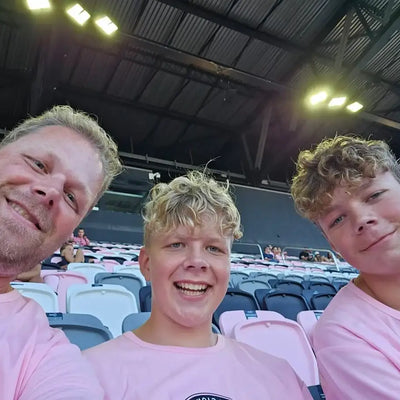Start with the shirt, not the autograph. Identify the version, season and competition, then check that fonts and patches belong together. Only after that should you evaluate the signature and proof. This article explains how to read namesets, when patches are correct, how pros complete a signature with the numbers-first method, and which proof providers do what. For background on how signatures are obtained and placed, visit our Collecting section.
Shirt first: replica, fanshop authentic, match issue, match worn
Replica may be unlicensed. Fanshop authentic mirrors official club and player specifications. Match issue is prepared for a fixture. Match worn is used in a match and always features the best shirt, although it may have wear or smudges from the match. Record the status up front. Note size, maker, season and customisations. If a number was signed loose and pressed later, keep that detail with the shirt’s notes.
Below is a fanshop shirt of AC Milan featuring Reijners. It is official, but not the match authentic version. With Puma they use different fabrics for the match version.

Read the shirt like a match report
A good check mirrors how a match is documented: competition, opponent, date and kit. Translate that into collecting: which league or European competition, which season, which kit and which patch set. Photograph the inner labels and the hem tag. Confirm whether the fabric and trims match the version you expect. The stronger your shirt ID, the easier it is to judge the autograph and its placement.
Fonts change with the competition
Some clubs, especially Nike and Puma teams, use different nameset fonts between domestic and European matches. Barcelona’s LaLiga numbers differ from their European set. Manchester City often runs several kits in a season and can have a domestic and a European font for each, so multiple valid combinations exist. New kits or commemorative releases can appear mid-season, especially for finals. Your task is to match the font to the competition and season that the seller claims, rather than assuming a single correct look.
The Manchester City nameset from the Premier League differs from the one used for the Champions League, even when wearing the same away kit:

Patches must match the story
League badges, European stars and winners patches follow competition rules. The patch should match the font and the stated context. If you see a European badge with a domestic font, pause and check. If a finals patch is present, confirm that the shirt aligns with the actual kit worn in that match. For example, Inter wore the yellow third kit in the 2025 UEFA Champions League final, which does not imply that this kit was used in league play.
Numbers first, shirt later: the pro method
Professionals often have players sign loose nameset numbers on a flat board. The autograph lands on a rigid surface, the lines stay crisp and the digit is later heat pressed onto the correct shirt and position. This method guarantees placement on the number and avoids seams and ventilation zones that break strokes. If you prefer on-body placement, give the autograph room to breathe and avoid panel edges, mesh and stitched crests that can wobble the line.

Cheap digits vs genuine namesets
Original namesets have the right film, colour tone, texture and cut quality. Cheaper sets can look overly glossy or dull, drift off the club hue, show soft edges or leave adhesive residue at the bond line. Ask for macro photos that show the texture, the edge profile and any inner-face maker marks. Inspect alignment and spacing from a straight-on shot rather than an angled glamour photo. Genuine sets also age in a predictable way, so look for even wear on nameset, patch and fabric.
Placement choices and what they imply
Placement is preference and player dependent. Large, flowing signatures may suit the shirt body better than a tight digit. Number placement looks tidy and predictable, especially when the digit was signed flat before pressing. Front signatures are usually less desirable for single-player pieces because the player identity is on the back, but they make sense for team-signed shirts or rare context-led moments. If placement matters to you, ask how the signing was set up and whether a rigid board or loose numbers were used.
Proof stack: Beckett, ICONS, Fabricks, Fanatics
Beckett. Provides expert opinion on autographs and also runs Witnessed signings where a representative observes the signature; verify by serial against the provider’s database. ICONS. Organises its own player sessions and supplies photo and video documentation with its COA and hologram. Fabricks. NFC tap-to-verify certificates widely used for match-worn and match-issued items, linking a shirt to structured item data. Fanatics. Runs athlete deals and labels signed items with code-verifiable holograms. Each source adds to the picture, but you still need the shirt version and competition pairing to make sense first.
Typical mix-ups and how to spot them
LaLiga font with a European patch. A European font on a listing that claims a domestic match. Finals patches on a shirt never worn in the league. Early retail shirts upgraded with later namesets that do not match the season tags. A compact numbers signature sitting on the shirt body with no space to flow. When any element looks off, slow down and verify the season, the kit and the competition rules one by one.
A simple buyer flow you can repeat
Confirm the shirt version and season with label and trim photos. Match the nameset font and colour to the competition. Check that patches and sleeve badges align with the same competition and season. Ask how the autograph was obtained and where it sits. If numbers were signed first, confirm the later pressing onto the correct shirt. Validate all serials, NFC links and COAs using the provider’s tools. Save scans and photos with clear, dated file names. Research takes time and practice, and Walkouts is happy to advise before you buy.
Related guides and resources
Frequently Asked Questions
Identify the season first, then confirm the club’s domestic or European font and pair it with the correct badge set for that competition.
Often yes, and clubs like Manchester City may run multiple kits and separate European fonts in one season, so verify the specific pairing you see.
It usually produces cleaner lines and consistent placement because the player signs a rigid digit that is later pressed onto the right shirt.
Check colour tone, texture and edge quality, look for maker marks where applicable, and request macro and straight-on photos for alignment.
Use Beckett serial checks, ICONS session media with COA, Fabricks NFC item data and Fanatics code-verifiable holograms to support the listing.









